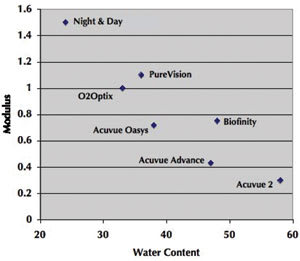contact
lens materials
Modulus, Water Content and Dk in Silicone Hydrogels: Part
1
BY
LORETTA B. SZCZOTKA-FLYNN, OD, MS, FAAO
Silicone hydrogel lenses are entering a new era with daily and flexible wear outcompeting 30-day continuous wear. The newest wave of products promotes lower modulus and higher-water-content materials as a way to address comfort, which may or may not affect the material's oxygen permeability.
In this first of a series of columns, I explore the relationship between water content, modulus and Dk together with experts in this field.
In silicone hydrogel technology, traditional theory governs that the higher-water-content materials will have a lower modulus, potentially enhancing initial comfort, and higher-water materials will in turn translate to lower Dk values. But is this theory set in stone? Can modulus and water content be dissociated in silicone hydrogels?
In Part 1, I pose this question to Noel Brennan, PhD, of Brennan Consultants in Melbourne, Australia, who has been researching contact lenses for more than 20 years.
|
|
|
Figure 1. Relationship between modulus and water content of various materials. |
Exploring the Relationship
Dr. Brennan responds to my question:
"Polymers are, by name and nature, composed primarily of chained molecules comprising long series of repeating units. There is an inherent flexibility to long chains depending upon the nature of the primary units. The units may consist of a simple monomer or of an almost endless combination of different monomers and even combined polymers. The polymer chemist introduces crosslinkers, fillers and other materials to pack the whole thing together in a desired fashion; these plus the nature of the primary units impact both the water holding properties as well as the stiffness of the material.
"Within the context of the subunits and crosslinking agents, one can fiddle around with these parameters in a quasi-independent manner," Dr. Brennan continues. "So, even with relatively unsophisticated polymers such as familiar hydrogel materials used for soft contact lenses, we see considerable variability in the modulus/water content relationship. For example, etafilcon A has a low modulus compared to other materials of similar water content. The degree of sophistication in silicone hydrogels is much greater and potentially allows even greater flexibility in this regard.
"To summarize, modulus is loosely but not absolutely related to water content," Dr. Brennan concludes.
How Much Oxygen?
In silicone hydrogels, the relationship between water content and modulus is fairly linear as traditional theory dictates. Figure 1 shows this relationship.
The real question is: How much oxygen reaches the cornea amidst these various material property combinations? We'll explore that question in future columns.
Dr. Szczotka-Flynn is an associate professor at Case Western Reserve University Dept. of Ophthalmology and is director of the Contact Lens Service at University Hospitals of Cleveland.




